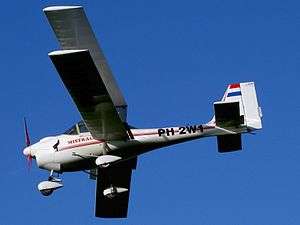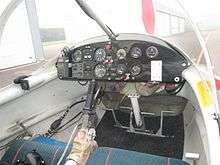Aviasud Mistral
The Aviasud Mistral is a French two-seat ultralight biplane built by Aviasud Engineering. This plane is notable as it has forward swept wings and side-by-side seating. The lower wings are movable and are used as the roll control (wing leveler).
| Mistral | |
|---|---|
 | |
| Role | Ultralight biplane |
| National origin | France |
| Manufacturer | Aviasud Engineering |
| First flight | 1985 |
| Introduction | 1986 |
| Number built | 250+ (1999) |
The aeroplane (along with the Sirocco) was taken over, and is still supported by, Aériane in 1989.[1]
Design and development
The Aviasud Mistral was designed by two Belgian engineers, Francois Goethals and Bernard d'Otreppe.
The prototype first flew in May 1985,[2] and the aircraft entered production with AviaSud engineering in Fréjus,[3] with the first production model having its maiden flight in February 1986.[2] Aviasud has built more than 200 Mistrals, it has also been built by Ultraleger Industria Aeronáutica Ltda in Brasil.[1]
.jpg)
The Mistral is a biplane of mixed wooden and composite construction, with forward swept wings, with the all-moving lower wings used as large ailerons, and a conventional, all-moving tailplane. It has a fixed tricycle landing gear and a nose-mounted Rotax piston engine. The Mistral has an enclosed cockpit with two side-by-side seats forward of the wings.[1][2]
On May 4, 1987, an Aviasud Mistral was flown to the geographic North Pole by Nicolas Hulot, a world first for this type of aircraft.
Variants

- Mistral
- Original version with 47 kW Rotax 532 engine.[5]
- Mistral 503
- Low powered, economy version with 37 kW (50 hp) Rotax 503 engine.[6]
- AE 206 Mistral
- Basic version, powered by 48 kW (64 hp) Rotax 582 engine.[2]
- AE 206 US
- "Ultra Silent" version with larger, lower geared propeller.[2]
- AE 207 Mistral Twin
- Twin engined version for advertising and surveillance work, with additional, pusher Rotax 503 engine above wing.[2] 30 built by 1999.[1]
Specifications (AE 206)
Data from Jane's All The World's Aircraft 1993-94 [2]
General characteristics
- Crew: 1
- Capacity: 1 passenger
- Length: 5.66 m (18 ft 7 in)
- Wingspan: 9.40 m (30 ft 10 in)
- Height: 2.25 m (7 ft 5 in)
- Wing area: 16.39 m2 (176.4 sq ft)
- Airfoil: NACA 23012
- Empty weight: 205 kg (452 lb)
- Max takeoff weight: 390 kg (860 lb)
- Fuel capacity: 60 L (16 US gal; 13 imp gal)
- Powerplant: 1 × Rotax 582 two-stroke, two-cylinder water-cooled piston engine, 48 kW (64 hp)
Performance
- Maximum speed: 155 km/h (96 mph, 84 kn)
- Cruise speed: 90 km/h (56 mph, 49 kn) (econ. cruise)
- Never exceed speed: 165 km/h (103 mph, 89 kn)
- Range: 530 km (330 mi, 290 nmi)
- Service ceiling: 4,575 m (15,010 ft) (at least)
- Rate of climb: 3.9 m/s (760 ft/min)
- Takeoff distance to 15 m (50 ft): 200 m (656 ft)
- Landing distance from 15 m (50 ft): 225 m (738 ft)
References
| Wikimedia Commons has media related to Aviasud Mistral. |
- Notes
- Taylor 1999, p.414.
- Lambert 1993, p.75.
- Lambert 1993, p.74.
- "François Goethals and Bernard D'Otreppe". Retrieved 30 October 2017.
- Taylor 1988, p.519.
- Taylor 1988, p.520.
- Bibliography
- Lambert, Mark (ed.). Jane's All The World's Aircraft 1993-94. Coulsdon, UK: Jane's Data Division, 1993. ISBN 0-7106-1066-1.
- Taylor, John W.R. Jane's All The World's Aircraft 1988-89. Jane's Defence Data, 1988. ISBN 0-7106-0867-5.
- Taylor, Michael J.H. (ed.). Brassey's World Aircraft & Systems Directory 1999/2000. London:Brassey's, 1999. ISBN 1-85753-245-7.
- (in Dutch)